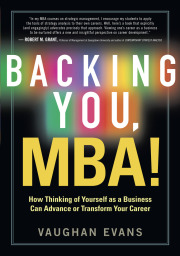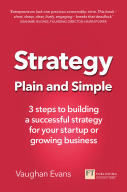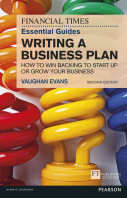
Backing You, MBA!
How Thinking of Yourself as a Business Can Advance or Transform Your Career
ARE YOU PLANNING TO GET AN MBA?
If so, what wil you do with it? Will you stay with your current or pre-MBA job or business? Or are you planning to shift career?
Think of yourself as a business. Use the tools of strategic due diligence to assess if you would back you in your current job. If so, use business strategy tools to make yourself more backable.
Or use tools of strategic mergers and acquisitions to shift to your ideal job or business – one which you are passionate about and where you’ll be backable.
The book uses case studies directly relevant to MBAs – for example, Jennifer, the former financial due diligence specialist thinking of switching to strategy consulting or private equity, and Gary, the manager seeking to return to his former company armed with a career enhancing MBA and a strategy for acquiring and applying new skills.
Backing You, MBA! How Thinking of Yourself as a Business Can Advance or Transform Your Career innovatively uses the very tools learnt at business school on yourself.
It will guide you in achieving career success post-MBA.
A FULL REVIEW OF BACKING YOU, MBA!
by PROFESSOR ROBERT M. GRANT
(published in Ambition, the magazine of the Association of MBAs, January 2012)
In my MBA courses on strategic management, I encourage students to apply the tools of strategy analysis to their own careers. Well, here’s a book that explicitly (and engagingly) advocates precisely that approach.
Viewing one’s career as a business to be nurtured offers a new and insightful perspective on career development. Our careers are by far the biggest investments we make in our lives. Vaughan Evans encourages us to deploy the same tools of rigorous business analysis to evaluate career decisions as a venture capitalist would to evaluate an investment in a start-up business.
Backing You, MBA! assumes that the reader is taking or has taken a degree in business management—whether at BA or MBA level. It invites the reader to consider their career as if it were a business, potentially worthy of being backed by an outside investor. If you find you are backable, it shows you how you can make yourself more so. If you find you are not, the book guides you on how to switch to a job where you are not only backable – defined as being in an attractive market and where you have a favourable competitive position – but also where your passion lies.
There are many books on career change on the market, the perennial bestseller being Dick Bolles’ What Color Is Your Parachute? Bolles takes a traditional bottom-up approach to job change – identifying your transferable skills, interests, values etc and seeing where best they can be applied. He illustrates this through his flower diagram – one of the few readily identifiable tools in the career field. Most other career guides follow variants of this approach.
Evans’s book differs in two main respects. By treating the reader as a business, Evans is able to deploy a range of established business tools to guide career decisions. Second, he takes a market-driven, top-down approach to career change—starting from where you would like to end up (what career fires you with passion), eliminating the non-starters, settling on two or three target careers, evaluating which one suits you best and helping you decide what actions to take to enter and flourish there.
To assess whether you are backable in your current job, Evans adapts tools of strategic due diligence – including some pioneered by himself in his day job as a specialist in this field. His approach to assessing the balance of risk and opportunity of you as a business – the 'Suns & Clouds' chart – is particularly illuminating (greatly helped with the example used of backing The Beatles in the early 1960s).
To assess how to become more backable in your current job, Evans tailors tools of business strategy to the individual. And for career change, Evans uses the tools of strategic fit found in mergers and acquisitions analysis. One such tool, the 'Hwyl Star' chart, adapts well for assessing your ideal job or business. It plots job market attractiveness against your likely competitive position, comparing the result with the hwyl (the Celtic concept of passion, fervour, spirit) it will engender in you. This could become a chart with legs in the career advisory world, along the lines of Bolles’ flower diagram.
The book is not all theory and analytics. Evans introduces a lively cast of four characters to illuminate the process, each of whom has a story to which a business student can relate. One is a middle manager and will use his MBA to boost his career advancement potential upon returning to his employer post-degree. Another is a self-employed economic consultant who wants to use her MBA to break into strategy consulting. A third is a former accountant who has her eyes on a career in private equity. And the final character is a young manager intent on escaping big business and starting his own venture. Evans shows how the tools can be used in practice.
Backing You, MBA! is clever and distinctive. It approaches career development and change from an entirely fresh angle, forcing the reader to think anew about their career direction. It is also highly readable, but it is 400 pages long and the analysis at times rigorous. The reader will need to invest a good few hours to benefit from this book. But the MBA student will already be familiar with many of the tools. And if he or she is not prepared to spend some time seriously analysing their own career prospects, one might wonder why they are at business school!
This is an important addition to the world of career guidance. It offers recent and prospective B-school graduates a novel and illuminating way in which to think about—and plan—their future careers. Moreover, it is an approach that is well adapted to the uncertain times in which graduates will be launching their careers. For students of business, it offers the opportunity to put into practice many of the analytic tools that they will have learned during their degree programmes, and to apply them to the most important decisions that they will ever take—their own careers.
Professor Robert M. Grant, Eni Professor of Strategic Management at Bocconi University, Milan, formerly at McDonough School of Business at Georgetown University and London Business School, and author of the top selling U.S. business school textbook on strategy, Contemporary Strategy Analysis




